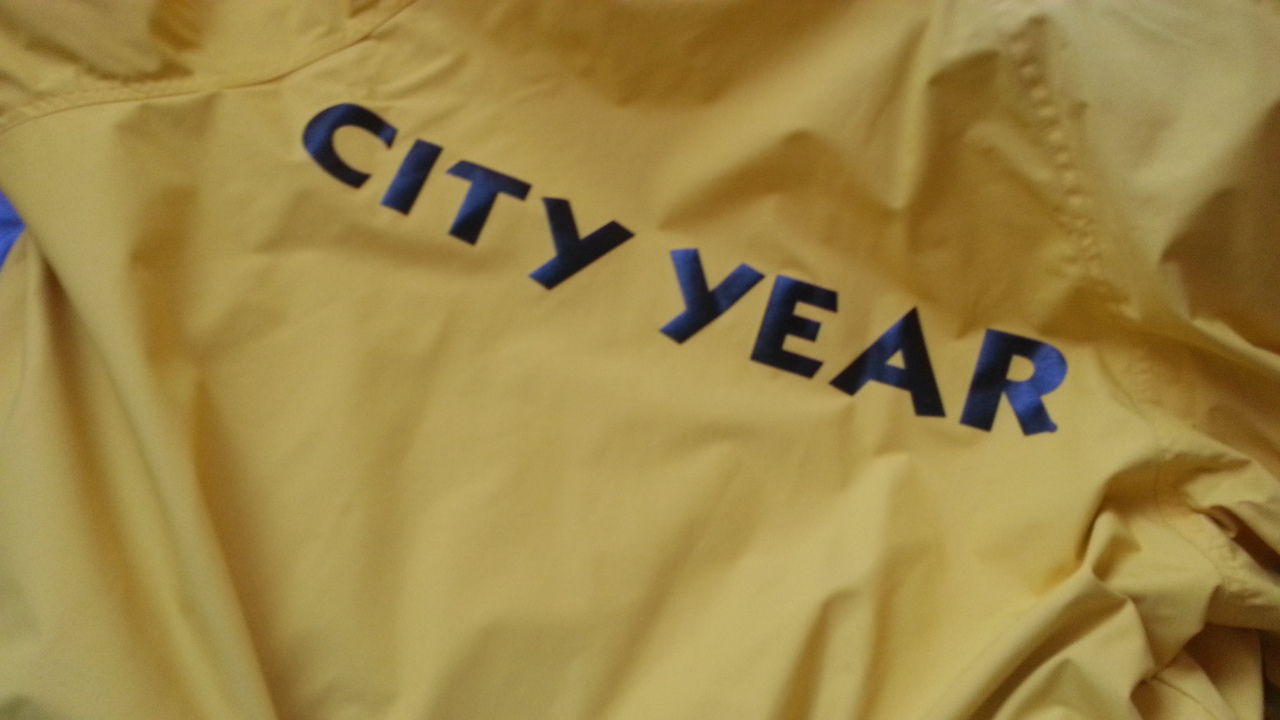The Dropout Crisis and City Year
City Year Los Angeles is now in 23 schools across South LA, Boyle Heights, and Pico-Union, and in 2012, the youth service organization has expanded to serve in high schools. The quality of the individuals help support the time spent trying to stop the dropout rate.
A typical day in City Year begins with a morning circle, before students even arrive at school. On this day, City Year members at Robert Louis Stevenson Middle School are getting ready for a big event to get students prepared to take the California Standards Test.
“Today we are pulling kids out of their classes, one on one, talking to them about their scores from previous years,” said Sara McDonald, a corps member on the team this year. “We are showing them how far away they are from reaching their goal, whether it be proficient to the next level, advanced to the next level, so basically giving them the tools they need to better their scores from last year.”
City Year began in 1988 as a nonprofit service organization in Boston. The ideal behind the organization was that one person could make a difference; but City Year hasn’t always served in schools.
The in-school, in-class model of service for City Year became more structured in the past decade with the development of the Whole School Whole Child model, based off of a 2007 report released by Johns Hopkins University. The study, along with the campaign statistic of “Every 26 seconds, a student drops out of school,” helped launch City Year’s “In School and On Track” Initiative, intended to reach 50 percent of all students falling off track.
Today, City Year is in 24 different locations in the United States, but Los Angeles has been a major area to watch develop. The site went from serving in only a handful of schools in the 2007-2008 year with 75 corps members to serving in 23 schools in the 2012-2013 school year, with over 225 corps members.
The expanded numbers don’t just stop at the corps level. For the first time, City Year Los Angeles has expanded into high schools, a move only a few City Year sites have ventured into thus far (New York, Philadelphia, Chicago, Washington D.C.).
The high schools in Los Angeles that City Year has partnered with are Belmont High School in Westlake, New Open World Academy and University of California – Los Angeles Community School at the Robert F. Kennedy Community Schools in Koreatown, the Math and Science and Engineering and Technology schools at Mendez Learning Center in Boyle Heights, Jefferson High School in South Los Angeles, and Manual Arts High School in South Los Angeles.
“That’s one of the things that we actually look for in City Year, overall feeder patterns,” says Arthur Shtern, a senior program manager in City Year Los Angeles serving his third year at Stevenson Middle School. “Our ultimate goal is to be in elementary schools that feed into middle schools that feed into high schools.”
The feeder pattern shows the depth of concentration in South Los Angeles more than any part of the city. Of the 23 schools City Year serves in, 14 are in South Los Angeles, including all eight elementary schools the organization serves in (99th Street Elementary, 109th Street Elementary, 116th Street Elementary, 122nd Street Elementary, Compton Avenue Elementary, Figueroa Street Elementary, Florence Griffith Joyner Elementary, Normandie Avenue Elementary). South Los Angeles also makes up four of the eight middle schools City Year Los Angeles serves in (John Muir Middle School, Clinton Middle School, Gompers Middle School, Markham Middle School).
John Muir Middle School is the primary feeder school into Manual Arts, one of the oldest high schools in the city, while Clinton Middle School feeds into Jefferson High School, also one of the oldest schools in the city.
Of the 14 South Los Angeles partnerships, five of them are a part of outgoing Mayor Antonio Villaraigosa’s Partnership for Los Angeles Schools (99th Street, Figueroa, Gompers, Florence Griffith-Joyner, Markham).
“Our primary goal is to just make sure that kids are back on track,” says Shtern, who first joined the organization in 2009 as a mid-year corps member out of the University of Michigan. “Meaning that, they maintain their grades or get higher grades so that when they enter high school, they’ll be prepared.”
City Year Los Angeles has changed the structure of their service in the last three years. As recently as 2010-2011, the organization served high schools in a different way. City Year’s Youth Leadership Corps program used to serve as a weekend program in City Year. The Young Heroes program was for middle school students, while the City Heroes program served as a program for high school students. The City Heroes Program was a weekend leadership development, social awareness, and community service program for high school-aged youth. The Los Angeles site ended the program in 2011 to focus solely on the Whole School Whole Child model.
Because of the renewed focus, City Year Los Angeles established or re-established new partnerships with 13 of the 23 schools the organization serves in.
A big measure that California schools look to improve upon is the academic performance index score (API). With this being the first year in high schools for City Year, Manual Arts and Jefferson both have a long way to go to reach California’s average goal of 800 points.
According to data from the College Board, only 21 schools reached the goal of at least 800 points.
Manual Arts (572) and Jefferson (546) ranked 158th and 174th, respectively. Mauro Bautista is the principal at Mendez, and he has been pleased with what City Year has bought to his school so far.
“We’re confident that having City Year here, with their support in the ninth grade, will help many of these ninth graders get off to a good start,” said Bautista. “And then it will be our responsibility as a school to support them in the tenth, eleventh, and twelfth so that they graduate.”

